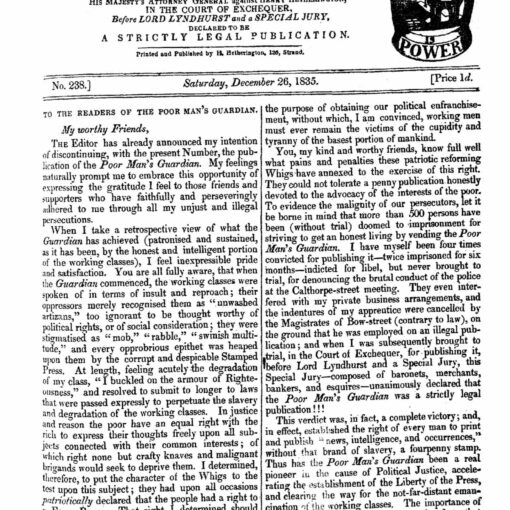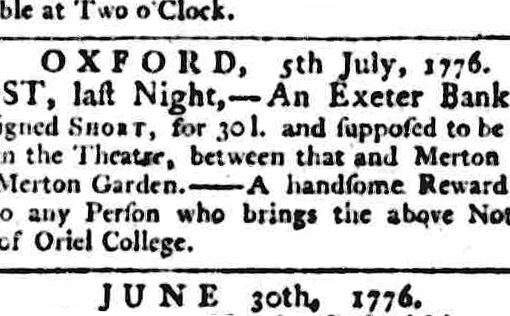Yorkshire Gazette – Saturday 03 May 1862
TUESDAY, April 29. – Before R. Evers, Esq.

OBSTRUCTING THE FOOTPATH. – A youth named Christopher Marsh was charged with obstructing the footpath near to the Railway Station. He was standing on the flags with the usual apparatus for cleaning the boots of any person in passing who desired having the operation performed. In so doing, the defendant obstructed the flags. He was ordered off two or three times by a policeman, but again returned to the place when the officer departed. The defendant was cautioned, and on promising not to offend in the like manner again he was discharged.
WEDNESDAY, April 30. – Before R. Evers, Esq.
ALLEGED FELONY. – A sailor named James Smith was charged on suspicion of having stolen a shirt. The police stated, however, that there was no immediate probability of an owner being found for the article, and the prisoner was consequently discharged.
THURSDAY, May 1.
Before R. Evers, Esq., and W. D. Hysman, Esq.
POCKET PICKING. – A young man named James Lyons, of Hull, was charged with having picked the pocket of Mrs. Elizabeth Agar in Colliergate. Mr. Mann appeared for the prisoner. Lyons accosted the prosecutrix in Colliergate on Monday afternoon last, and asked the road to Goodramgate. Mrs. Agar politely showed him, and at the same time unwittingly eased her pocket of its contents. She discovered her loss simultaneously with the departure of the prisoner, and she accordingly gave information to the police, who apprehended the prisoner a short time afterwards. The culprit stated that he was respectably connected, and that he was visiting an uncle residing in Beedham’s Court, Skeldergate, and he also gave the name of James Moran. Police-constable Whitwell interrogated the uncle as to the truth of this statement which turned out to be true, with the exception of the prisoner’s name which was a feigned one; his real name being Lyons. – He was convicted and sentenced to be imprisoned for one month.
FEMALE THIEF. – A convicted thief, named Mary O’Melia, who has only been a short time out of prison, pleaded guilty to having stolen, at different times, a pair of trousers and a coat, the property of Mr. Aubrey Moore, tailor and clothier, Walmgate. She was committed to prison for three months.
Analysis, Context, and Law in 1862
1. Social and Legal Context
In 1862, England’s legal system was firmly rooted in Victorian values, emphasising public order, morality, and respect for authority. The cases documented here reflect a society keen on regulating behaviour in public spaces and punishing even petty thefts or misdemeanours.
- Magistrates’ Courts: Local justices of the peace, like R. Evers and W. D. Hysman, presided over these cases. Their role was to deal with minor offences and preliminary hearings for more serious cases.
- Law Enforcement: Policemen were becoming more organised after the establishment of the Metropolitan Police Force in 1829. They were responsible for maintaining public order and investigating crimes.
2. Case-Specific Insights
- Obstructing the Footpath (Christopher Marsh): Marsh’s case exemplifies the enforcement of public order laws. By standing on the pavement near the railway station to clean boots, he obstructed free passage. Under the Town Police Clauses Act 1847, such obstruction could lead to a warning or fine. The leniency shown (a caution) indicates the magistrate believed the offence was minor and unintentional.
- Alleged Felony (James Smith): This case highlights the principle of evidence in Victorian law. Without proof of theft or an identifiable owner for the stolen shirt, the case could not proceed. The sailor’s discharge reflects the legal need for corroborative evidence or an accuser.
- Pocket Picking (James Lyons): This was a straightforward theft, where Lyons exploited Mrs. Agar’s distraction. The sentence of one month’s imprisonment was typical for first-time offenders in petty theft cases. Victorian justice emphasised both punishment and public deterrence.
- Female Thief (Mary O’Melia): Mary O’Melia’s case reflects harsher sentencing for repeat offenders. The court sentenced her to three months’ imprisonment, underscoring a zero-tolerance approach to habitual crime, especially for women who had fewer social safety nets than men.
3. Broader Legal Framework
The laws applied in these cases were influenced by:
- The Vagrancy Act 1824, addressing loitering and suspicious behaviour in public spaces.
- The Larceny Act 1861, defining theft and setting penalties.
- The growing professionalisation of police forces, who were expected to act promptly and effectively in such incidents.
Victorian prisons were designed as places of punishment and reform. Short sentences like those handed to Lyons and O’Melia were intended to deter future crimes, but the conditions were often harsh, involving labour and strict discipline.
This snapshot of Victorian justice illustrates a rigid and moralistic society that sought to maintain order through swift and often severe measures. The emphasis on evidence, clear procedures, and public accountability reflected a legal system in transition, balancing traditional values with emerging professional standards in law enforcement.
The Yorkshire Gazette

The Yorkshire Gazette was first published in York on 24 April 1819 by John Wolstenholme, a bookseller and printer. Initially a weekly Conservative newspaper, it championed the interests of landowners and farmers while supporting the Established Church. The paper began with just four pages and was priced at sevenpence. Wolstenholme managed the publication on behalf of a joint stock company.
Evolution Under New Ownership
In 1828, Henry Bellerby, another bookseller and printer, took over the Yorkshire Gazette. Under his stewardship, the newspaper expanded to eight pages in July 1838. The following year, the company purchased the York Chronicle, a newspaper established in 1772, which Bellerby had been publishing since 1836. The two publications were amalgamated in 1840.
Bellerby became a prominent figure in York, serving as Sheriff of the city in 1844.
Foster’s Era
In 1852, James Lancelot Foster, a reporter by trade, succeeded Bellerby as editor and publisher of the Yorkshire Gazette. Over the next thirty years, Foster oversaw significant growth, increasing the newspaper to 12 pages in 1855. Like his predecessor, Foster became a notable local figure, serving as Sheriff of York in 1870. Foster passed away in 1883, and the Yorkshire Gazette was acquired by the North and East Yorkshire Conservative Newspaper and Printing Company Ltd.
Changes in Publication
In 1884, the Yorkshire Gazette transitioned to a daily format, but financial losses led to its return as a weekly publication in 1886. In 1905, the newspaper was taken over by the North of England Newspaper Company, which soon absorbed the Malton Gazette and the South Durham and Cleveland Mercury.
Final Years
The Yorkshire Gazette continued until 1954 when it was incorporated into the Yorkshire Herald. Its legacy remains a testament to its role in advocating Conservative values and documenting the social, political, and agricultural life of Yorkshire during its long history.
Victorian Justice in Action: Exploring petty crimes, punishments, and societal values from the Yorkshire Gazette, May 1862. #VictorianEra #History #LawAndOrder #Yorkshire




